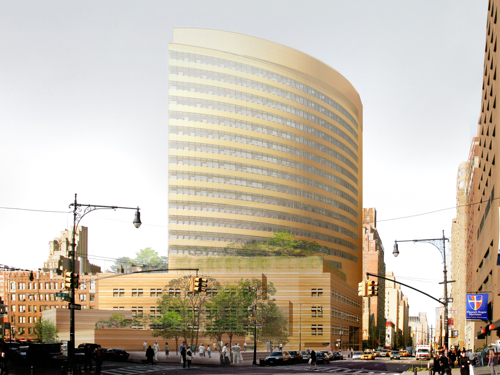
In October, when members of the Landmarks Preservation Commission made what they called the hardest choice of their landmarking careers—whether or not to grant St. Vincent’s Hospital the right to demolish Albert C. Ledner’s iconic National Maritime Union in Greenwich Village and build a 300-foot-tall hospital tower on the site—the commissioners made two things clear. First, any votes in favor of the hospital’s right to build were not an endorsement of its designs for the new tower, which several commissioners deemed out of scale and character with one of the city’s oldest historic districts. And second, St. Vincent’s should do everything in its power to explore alternative proposals that could mitigate its impact on the neighborhood.
So when the hospital and development partner Rudin Management returned to the commission with their latest plans on December 16, some commissioners expressed shock and surprise when presented with essentially the same proposal unveiled in May. “For the better part of a year, we’ve been looking at this project, and I think it is as inappropriate as when we started,” commissioner Stephen Byrns told the applicant. “I cannot even begin to comment on the architecture given its out-of-scale bulk.” Commissioner Elizabeth Ryan even poked fun at the design. “Ever since you presented us with your designs, there has been talk about how the tower disappears from its base,” she said. “I think it needs to disappear entirely.”
Thus began round two in the saga of St. Vincent’s and the O’Toole Building, a project that is all but certain to drastically reshape its West Village neighborhood. Indeed, an alternative design presented for the tower caused almost as much anger as it was meant to assuage, though it also prompted several commissioners to offer their support for the hospital’s original plans.
The new proposal, presented by Ian Bader, a principal at Pei Cobb Freed, which is designing the hospital for St. Vincent’s, offered a rectilinear shape in contrast to the previous lenticular design. With its sheer facade rising from the street wall, the alternative would shave just 36 feet off its taller sibling, the maximum height the developers argued they could possibly trim.
“Pretty significant square footage has been taken out of the hospital already,” Lou Meilink, a principal and health care planning expert at Ballinger, told the commission. “We just couldn’t make any more cuts and still have a functioning level-one trauma center.”
An alternate plan presented to the landmarks commission gives the tower a rectilinear volume, with sheer walls rising from the street. Despite the reconfiguration, it is only 36 feet shorter than its 299-foot sibling.
But commissioner Margery Perlmutter said that the lackluster alternative—like one other mid-block strategy that had been presented over the summer—did not show appropriate deference to the commission or the necessary due diligence to consider all possibilities for a new hospital. “It’s a little bit frustrating when every time we ask for alternatives, we get an off-handed response that lacks the quality, details, and attention of the original proposal,” she said.
Instead, like a number of her colleagues, she endorsed a proposal put forward by Byrns that would either bridge or build over a section of West 12th Street, thus allowing the hospital to incorporate a 15,000-square-foot triangular lot that is planned to serve as a loading dock. The commissioners believe this could greatly reduce the height of the building, but the developer said that between the complexity of demapping the street and the parameters of making the hospital function properly, such an approach would be nearly impossible. “It’s like a Swiss clock,” said Shelly Friedman, the applicants’ counsel.
Furthermore, the developer believes it may already have the support it needs on the commission to pass its primary proposal. “We heard several supportive comments today,” Friedman told AN after the meeting. “Unless we hear otherwise, that is how we would expect the rest of the discussion to go, making the lenticular design a success for the commission.” Indeed several commissioners said that the alternative proposal obviously did not work, and that they favored the lenticular design. Commissioner Fred Bland called it “ingenious,” and commissioner Christopher Moore said, “I am inclined to support it.” And, perhaps most importantly, commission chair Robert Tierney seems to back the lenticular plan. “My sense is it’s headed in the right direction,” he said.
Michael White, a land-use attorney, blogger, and commission gadfly, said he had his own theory for why the hospital was fighting so hard to maintain the height of its tower. “At its heart, this is a real estate deal,” he said. “They want to bulk up as much here as they can so they can bulk up as much as they can on the Rudin site.” He was referring to the site of the old hospital building across 7th Avenue, which St. Vincent’s is selling to the Rudin family for $300 million to help fund hospital construction. The Rudins then hope to build an FXFowle-designed 20-story condominium tower on the site. White believes the developer will use the comparatively taller new hospital tower to defend the massive-by-Village-standards height of its new building.
development plans call for the current hospital (left) to be replaced by a condo tower and converted residential structures along 12th Street (right).